



|
 
|
|
Vortrag im Naturhistorischen Museum Mainz Dr. B. Pfeiffer Keplers Stern von Bethlehem und die Trigone der Großen Konjunktionen Sonntag 27.11.2016, 15:00
Vorheriger Vortrag |
|
I obtained my master and PhD degrees in experimental and applied physics at the
II. Physical Institute
of the Justus-Liebig-University in
Gießen [
Short biography of Justus v. Liebig]. Under the supervision of
Prof.
Dr. H. Wollnik I constructed a gas-jet transport system for short-lived
fission fragments at the
LOHENGRIN
separator at the Institut Laue-Langevin (ILL)
in Grenoble, France. I then applied
this system for nuclear structure experiments with
b- and g-spectroscopy.
(An impression of the impact of my thesis work may be obtained from
publications which cited the technical and
nuclear structure articles derived from my master and Ph.D.
thesis.)

|
|
|
GSI Ann. Rep. 2008, GSI Ann. Rep 2009, GSI Ann. Rep. 2010, GSI Ann. Rep. 2011, GSI Ann. Rep. 2012; a comparison between the new atomic mass evaluation AME2012 [published in December 2012 in Chinese Physics C36] and the last edition AME2003 can be seen in the figure at the right side) and the International Network of Nuclear Structure and Decay Data Evaluators (NSDD) at Nuclear Data Services of the IAEA and National Nuclear Data Center at Brookhaven National Laboratory. Keeping my workplace at the GSI, since January 2011 I have returned to my first scientific affiliation, the II. Physikalisches Institut in Gießen as collaborator of the IONAS group. In the near future we want to start an evaluation of b-delayed neutron properties in an international cooperation. An overview of the present state of research and data compilation / evaluation can be found in the Summary Report of Consultant's Meeting on Beta-delayed Neutron Emission Evaluation
|

|
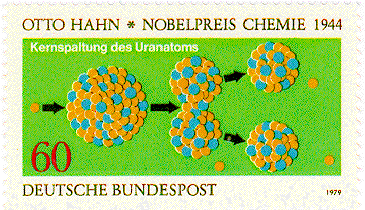
|
|
|
|
All my research is more or less related to nuclear fission, which was
discovered in close collaboration by
Otto Hahn,
Lise Meitner and
Fritz Strassmann at the Kaiser-Wilhelm Institut in Berlin.
After the war, the institute was moved to Mainz and refounded as
Max Planck
Institut für Chemie (Otto Hahn Institut). Fritz Strassmann was director
at the MPI and as professor at the university, he established the Institute for
Inorganic Chemistry (later the Institute of Nuclear Chemistry).
Zum Vollmond im März 2001 hat die IAU zwei neue Kleinplanetennamen bekanntgegeben [nähere Informationen]:
|
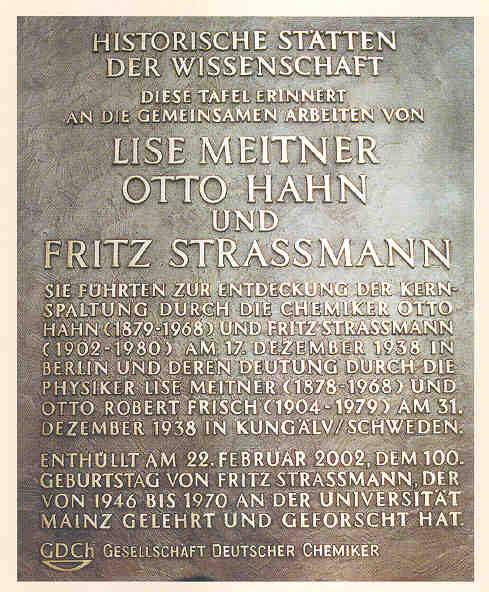
|
![]()
Our group studies nuclear structure of very short-lived exotic isotopes by
detecting and
analysing the radiation emitted following the decay of these highly unstable
nuclei. As the production and separation of these rare species demands quite
sophisticated instrumentation, such experiments are performed in close
collaboration with collegues at several research facilities as:
|
|
Important contributions to the understanding of nuclear structure far from
stability are derived from the study of fragments from thermal neutron
induced fission of 235U at high-flux reactors, as the HFR of the
ILL, Grenoble. The most neutron-rich isotopes were obtained for the alkaline
elements
Rb and Cs, as they combine a high thermal ionisation efficiency with short
release times from carbon matrices impregnated with uranium carbide.
As an example, detailed g-spectroscopy following
the b-decay of 59 ms 99Rb is shown below:
With advanced separation techniques, the range of elements accessible to
detailed nuclear spectroscopy has been extended: on the one side, refractory
elements are obtained by the chemically non-selective ion-guide
technique (IGISOL,
Eur. Phys. J. A2 (1998) 17 and in combination with fast chemical
separations applying the SISAK technique at the Mainz TRIGA reactor
Eur. Phys. J. A1 (1998) 285) and on the other side, highly selective Laser ion
sources allow to study nuclei with extremely low production yields in
the presence of extremely high contaminations (ISOLDE,
recent results on heavy Mn isotopes in
Phys. Rev. Lett. 82 (1999) 1391). At LISOL, the
combination of both techniques has yielded promising first results on
neutron-rich nickel and cobalt isotopes
(
Phys. Rev. Lett. 81 (1998) 3100). More sophisticated spectroscopy is possible for higher yields (as
g-g-time coincidences to
determine level lifetimes; see, i.e.
Ann. Rep.
1995, p. 24), allowing to construct
detailed excitation schemes from which spins, parities, nuclear
deformations (for a visualisation of shapes click
here or see P. Möller et al. Nature 409 (2001)
785) can be extracted. Then, applying
b-g coincidence
techniques, Qb-values can be measured
and by this the
important nuclear masses. Comparing these results to theoretical mass
models (a recent publication: At. Data Nucl. Data
Tables 66 (1997) 131), hints for further improvements are
obtained, which are essential for applications in fields as nuclear
astrophysics dealing with far unstable nuclides not accessible for
measurements with nowadays techniques (On-line access to calculated
Nuclear Properties
for Astrophysics by P. Möller).
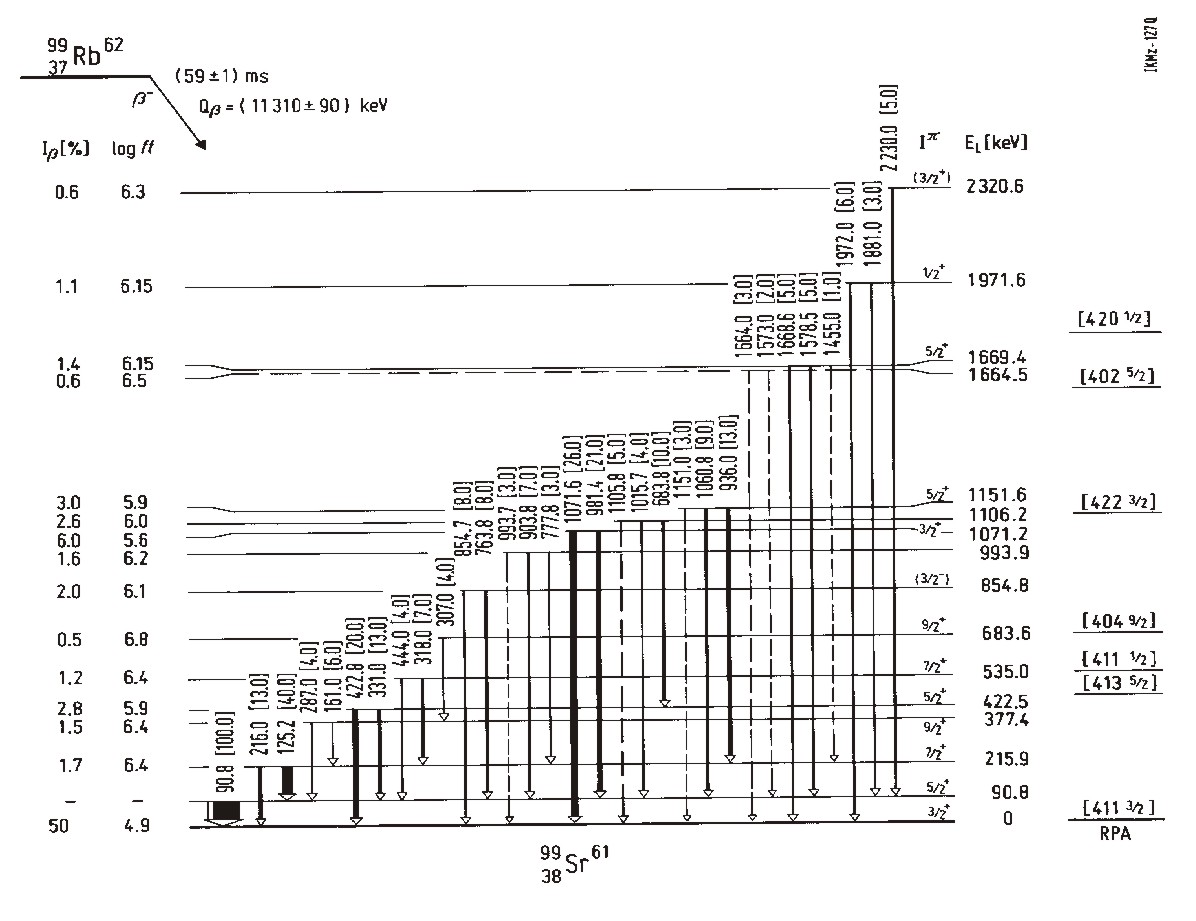
Decay scheme of 99Sr from
b-decay of 99Rb, the
most neutron-rich isotope obtained at OSTIS, for which detailed spectroscopy
was possible (NSR 1985PfZZ). For extensions of the rotational bands to higher
spins from
the b-delayed neutron decay of 100Rb
observed at ISOLDE, see
Ann. Rep.
1998, p. 23) and
Phys. Rev. C63 (2001) 054302.
For the nuclides with very low production yields, often only "gross"
properties as half-lives and the delayed-neutron emission probability
Pn can be obtained (i.e.
Ann. Rep.
1995, p. 22;
Ann. Rep.
1998, p. 24; tables of measured and predicted T1/2 and
Pn-values can be downloaded in
PDF).
Recently, in collaboration with the Theoretical Division at Los Alamos, existing
experimental data for fission products were re-evaluated and compared to
theoretical predictions:
B. Pfeiffer, K.-L. Kratz, and P. Möller
Status of Delayed-Neutron Precursor Data: Half-Lives and Neutron
Emission Probabilities; Report: LA-UR-00-5897 and Progr. Nucl.
Energ. 41/1-4 (2002) 39-69.
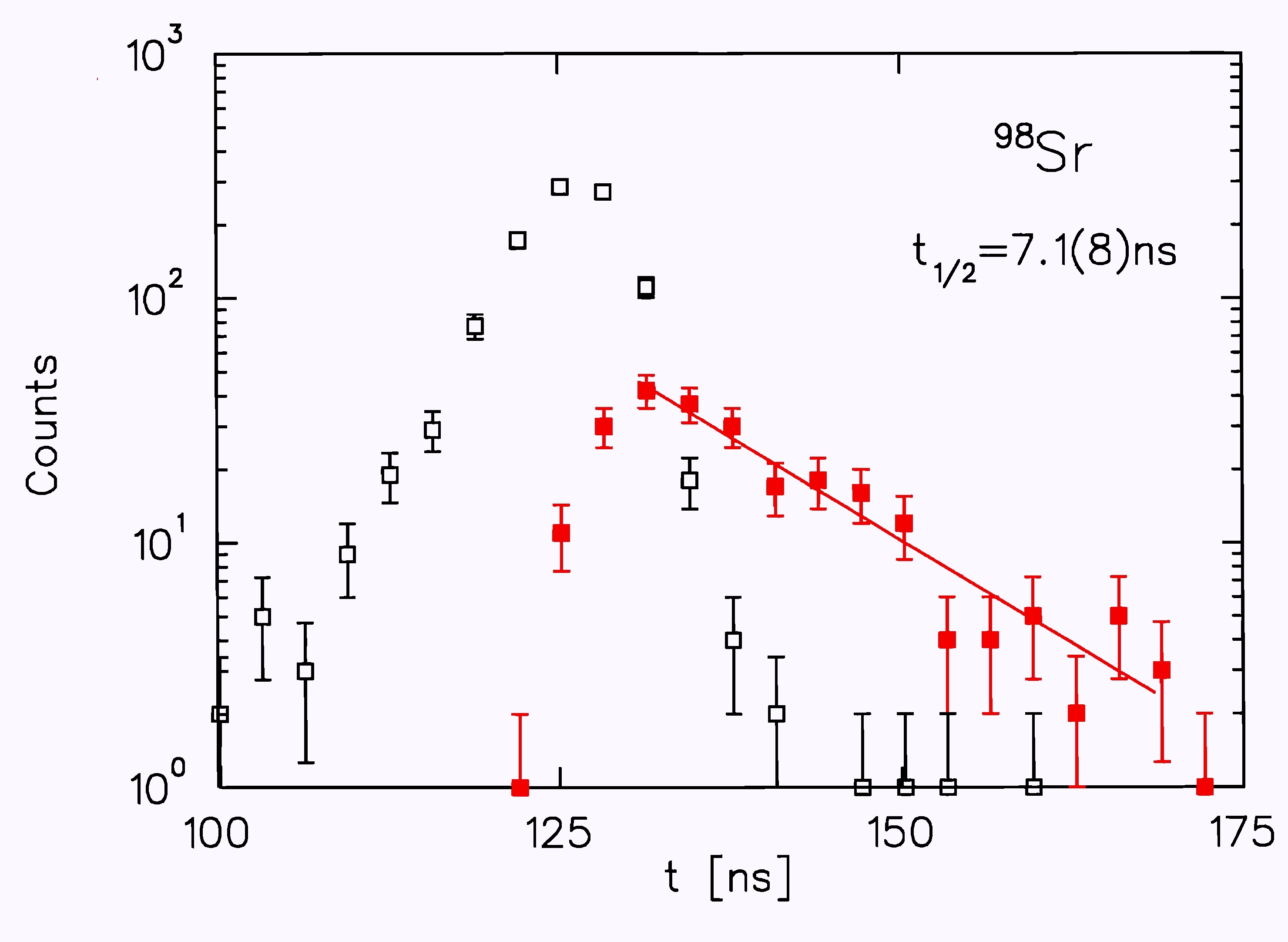
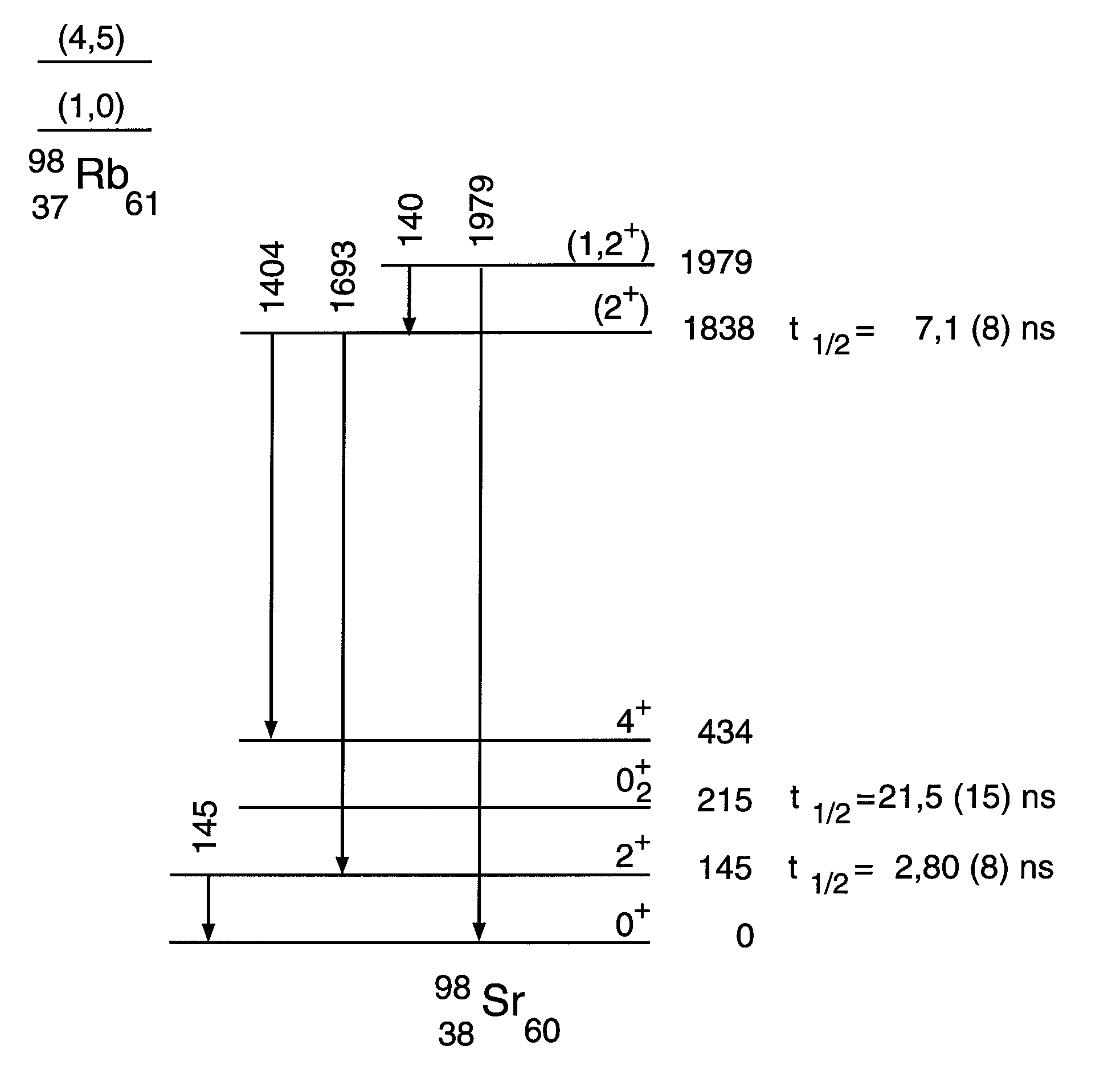
Fit to the delayed coincidences between the 140 keV line feeding
the isomeric level at 1838 keV and the deexciting transition of 1693 keV
(filled red squares). For comparison, the coincidences between the 145 keV
and the 1693 keV lines with the known t1/2=2.8 ns of the
2+ state are shown (open blue squares).
Partial level scheme of 98Sr showing the transitions
relevant for the discussion of the isomeric level at 1838 keV.
For further details, see
Ann. Rep.
1995, p. 24.
Further analysis revealed a deformed K=3 band with probable even
parity built on the isomer at 1838 keV. It is interpreted as a
two-quasi-neutron excitation in accordance with a quantum Monte Carlo pairing
calculation in an article in
Phys. Rev. C65, 024318 (2002).
 The nuclear physics data are then used as input to nuclear astrophysics
calculations of the interconnected items of energy production and
nucleosynthesis in stars (see, e.g. Phys. Rep. 294 (1998) 167-263,
Il Nuovo Cimento 111A (1998) 1043 (PDF-file)
or
Nuclear Structure Studies at ISOLDE and their Impact on the
Astrophysical r-Process in Hyperfine Interactions 129 (2000) 185).
We are concentrating on the reproduction of the solar-system
abundance pattern of the heaviest elements synthesized in the rapid neutron
capture process (or
r-process), which takes place in type II supernovae
explosions representing the final stages in the life of massive stars
(For a review of our method see: K.-L. Kratz et al., Ap. J.
403, 216(1993)).
Comparing our calculated with observed patterns, we can derive information
on astrophysical as well as nuclear structure parameters
(Ann. Rep. 1996 and B. Pfeiffer et al.
Z. Phys. A357, 235(1997)
).
The nuclear physics data are then used as input to nuclear astrophysics
calculations of the interconnected items of energy production and
nucleosynthesis in stars (see, e.g. Phys. Rep. 294 (1998) 167-263,
Il Nuovo Cimento 111A (1998) 1043 (PDF-file)
or
Nuclear Structure Studies at ISOLDE and their Impact on the
Astrophysical r-Process in Hyperfine Interactions 129 (2000) 185).
We are concentrating on the reproduction of the solar-system
abundance pattern of the heaviest elements synthesized in the rapid neutron
capture process (or
r-process), which takes place in type II supernovae
explosions representing the final stages in the life of massive stars
(For a review of our method see: K.-L. Kratz et al., Ap. J.
403, 216(1993)).
Comparing our calculated with observed patterns, we can derive information
on astrophysical as well as nuclear structure parameters
(Ann. Rep. 1996 and B. Pfeiffer et al.
Z. Phys. A357, 235(1997)
).
 |
Elemental r-abundances calculated with ETFSI-Q masses (red line)
[J.M. Pearson et al., Phys. Lett. B387 (1996) 455] are
compared to the respective Nr,solar values (green filled circles).
Superimposed are measured abundances (blue filled squares) from the
metal-poor halo star CS22892-052 [C. Sneden et al., Ap. J. 591 (2003)
936], which were normalized to the solar rare-earth values (see J.J. Cowan et al., Ap.J. 521 (1999) 194-205). |
The observation of "solar" neutron-capture element abundance distributions in
four metal-poor halo stars indicates to a
unique r-process site in the Galaxy (at least for Z > 55). The
estimated decay-age of T = (15.6 ± 4) billion years for the thorium in
these stars represent a lower limit for the age of the Galaxy and (evidently)
the Universe (see,
B. Pfeiffer et al. in
IX. Workshop on Nuclear Astrophysics and
J.J. Cowan et al.,
Ap.J. 521 (1999) 194-205).
Recently, new perspectives for radioactive dating of old stars opened with the
first simultaneous detection of thorium and uranium in the metal-poor star
CS31082-001 by R. Cayrel et al. in Nature 409 (2001) 691.
Combined with the
Basel-Mainz initial r-process production values (see J.J. Cowan et al.,
Ap.J. 521 (1999) 194-205) an age of (12.5±3) Gyr was obtained (for more
details see R-Process
Cosmo-Chronometers).
(These age determinations are cited in Ned Wright's
Frequently Asked Questions in Cosmology: How old is the
Universe?.)
First calculations on the proposed two r-process components can be found in
my
contribution to the conference Nuclei in the Cosmos 2000.
Further information on the origin of the elements in our Galaxy may be obtained from the analysis of the composition of Galactic cosmic rays. The ultraheavy cosmic rays (heavier than neodynium with Z=60) appear to come from a pure r-process (explosive) source (see Trek and ECCO-detectors on the space stations Mir and ACCESS in preparation for ISS in 2005, respectively). If confirmed by the next generation of experiments (as the ECCO-detector or advanced versions of TIGER, the Trans-Iron Galactic Element Recorder as first payload for the Ultra-Long Duration Balloon Project), all the heavier neutron-capture elements originate in a unique explosive scenario, which remained unchanged over the history of the Galaxy from the onset of r-process nucleosynthesis in the first halo stars until present times (as evidenced by the Galactic cosmic rays with an estimated mean lifetime in the order of 10 million years). [See, e.g. R.E. Lingenfelter et al., Ap.J. 591 (2003) 228 and talk at Seeon Workshop]
Some articles of our astrophysical collaborations have already been listed as part of the Nuclear Astrophysics Bibliography.
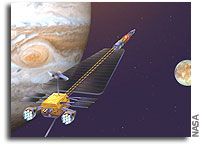 |
In perhaps even not so far future, nuclear fission and space exploration
will be intimately linked. NASA has started projects to power spacecraft
by fission reactors:
Project Prometheus. [Reactors to be started in orbit, not
to lift-off from the surface by nuclear explosions as in the (in)famous
"Project Orion" of the 50/60'ies. A project of General Atomic
developped in parallel to the TRIGA reactor by partly the same persons.]
As a first application,Project JIMO
(Jupiter Icy Moons Orbiter) is foreseen. The high
electrical power output of the fission reactor will be used for electrical
propulsion and will also power for a first time energy consuming scientific
payloads as radar emitters to search for the presumed oceans beneath the
ice crusts of the 3 outer Galilean satellites of Jupiter. The electrical
power will also enable the use of high-gain antennas to transmit a high
data rate to Earth. For the design of the reactors, nuclear structure data are needed, data which also our group has measured since a long time. And one should not forget to mention that neutron detectors similar in design to the ones applied in our research are on board the "Mars Odyssey" orbiting Mars and searching for water beneath the surface. |
 |
|

|
 |
![]()
|
|
|
![]()
 |
Last updated March 2012. | 
|
Ich bin nicht verantwortlich für die Inhalte anderer Web-Seiten, auf die ausgehend von diesem Server unmittelbar oder mittelbar zugegriffen werden kann! |